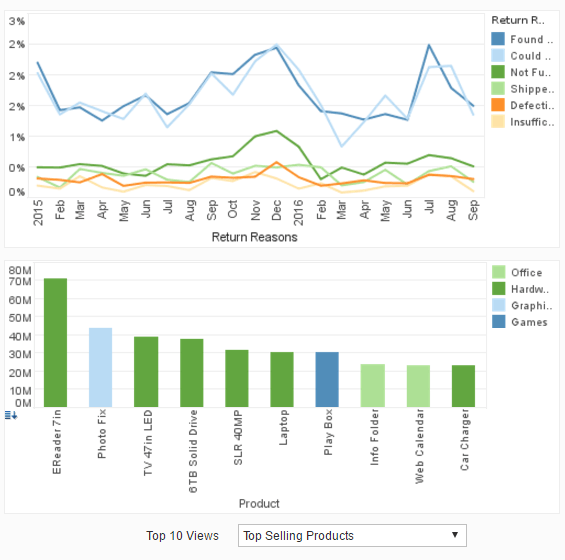InetSoft, a Data Integration Company with a Data Mashup Platform
This is a table of contents of useful information about the data mashup platform that is included in InetSoft's business intelligence software for dashboards, reporting, and analytics, StyleBI:
Data Mashup Information - Data Mashup, at its basic definition, means combining disparate data sources that were not previously architected to be used together. In a data warehouse environment with rigid ETL process, data mashup yields other benefits, particularly in allowing prototyping of data manipulations before committing to new, official ETL definitions and transformations. Data mashup is a central capability of InetSoft's StyleBI business intelligence software. It's a platform focusing on operational BI with an intuitive user interface that accelerates usage of BI. Requirements as diverse as reporting, OLAP, scorecards, dashboards, visualization, and ad hoc analysis are all met in a unified application...
Data Mashup Product Demonstration - First, I am going to walk through what the end-user can do with our BI application, and so I will show a bunch of pre-built interactive dashboard examples. Then I will segue a little bit into the self-service BI capabilities, showing both data mashup and the interactive visualizations that again we are putting in the hands of the end-users. And then I can touch on a couple of the new features that are specific in Version 11 of our StyleBI application. Feel free to ask me questions as we go along. If you would like to see something or if you are curious about little bit more specifics behind a feature or user functionality, just let me know...
Data Mashup Solutions Offer a Significant Cost Reduction - From an efficiency perspective, data mashup solutions offer a significant cost reduction compared to replication based strategies, but even more importantly from an ongoing standpoint, for future BI solutions and reacting the changes, development time is significantly shorter and therefore cheaper. Typical projects take four to six weeks in any of those examples that I have shown you here. ROI for initial projects can be less than six weeks, and you are always building this data services capability as you go. InetSoft is very well recognized in this industry as a leader in data mashup, and our one BI product has the broadest range of capabilities and flexibility and yields very high performance. Let’s turn to the audience questions. We have two questions that are very similar that we can address at the same time. One of them is on the limits of data virtualization in terms of dataset size and performance? And the other one is a question on performance assessment. As we have mentioned, it depends on the expectations of the business. Data virtualization handles mainly two types environments. The first is operational environments without many data sources but large numbers of users, a 100, 1,000 or 10,000, where low latencies are required. This is typical of call enter, and the application is so see the entire customer view. Here you have got no baseline on data virtualization tools capability of matching congruent connections and optimizing combinations from those data sources...
Data Mashups and Governance - Especially when you're trying to work with many different data sets, and there’s the security angle here and there is also a data quality or data governance angle to this as well. But if you start talking about meta data, it really is important that you manage these definitions well because otherwise you start mixing and matching apples and oranges, and that cause all kinds of problems. Definitions are a little bit of an Achilles heel today in data management, and I think that to me, one of the important areas, and perhaps the other guests will be able to comment on this later in the show, is how the end user is going to interpret the mashup to make sure there are no issues in the way they are interpreting and using the mashup...
Data Mashups Combining Enterprise Data and External Sources - Byron Igoe: Right, I mean, I may be somewhat bias given the kind of Bi technology that my company provides, but when I think about data mashups and the users being able to manipulate and combine not only the enterprise data but the external sources, the fact that it’s all still metadata, and you see the provenance, really trace it back to where that it is coming from, that you can really take that information for what it’s worth, you know, you can see that oh, okay they are just mashing up some of my sales reports from last quarter with a Twitter feed, so I will take that with a grain of salt. Jim Ericson: Taking it with a grain of salt, but also may be you make, may be you roll that out for people to be able to look at it generally more broadly. Eric Kavanagh: Feel free to send those tweets out there, lot of good tweets already today. Thank you folks for that, and we will be right back. Yeah, we heard that metadata bell in the opening segment there. That’s our favorite word because it’s just everywhere in this conversations, there it is. One of these days we will may be have some kind of a contest where the first person to tweet a bell something in there in it with referencing the metadata bell will wins a trip somewhere, maybe to New York, the Source Media Headquarters. Jim Ericson: Oh, I am too scared away exactly..
